Wakulla Springs — January 11-12, 2013: Dive Summary
Wakulla Springs — January 11-12, 2013: Dive Summary
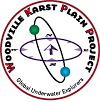 Dive Date: January 11-12, 2013
Dive Date: January 11-12, 2013Location: Wakulla Springs, Florida
Objective:
The objectives for the dive were primarily maintenance and cleanup in advance of future exploration dives. Conducting maintenance dives separate from exploration is preferred due to support limitations and safety requirements.
Project Baseline Observations:
Weather Conditions: Partly Cloudy
Air Temp (F): 70
Water Temp (F): 68
Avg Depth (ft): n/a
Max Depth (ft): 295
Total Run Time: 8.5hrs
Basin Observations at Depth (ft): 120
Basin Visibility (high, medium, low): low
Basin Turbidity (high, medium, low): medium
Dive Observations at Depth (ft): 290
Dive Visibility (high, medium, low): low
Dive Turbidity (high, medium, low): medium
Water Current Speed (high, medium, low): high
Water Current Direction: out
Notable Flora: minimal
Notable Fauna: fish
Comments: Poor visibility in basin and cave
Activities:
1. Extract safety tanks from 2,200ft and 3,500ft in A-Tunnel – COMPLETED
2. Extract FGS flow meter from C-Tunnel – COMPLETED
3. Remove unnecessary guidelines – COMPLETED
4. Assess conditions at A/B/C, A/D, A/K intersections in cave – COMPLETED
5. Prepare, clean and re-install basin habitats – COMPLETED
6. Photographs – COMPLETED
Summary:
WKPP divers successfully completed all planned objectives. Visibility in the cave system is poor and estimated at 20ft in A-Tunnel. C-Tunnel is more clear but still hazy and estimated at 40ft. There is noticeable discharge/outflow. Visibility does not improve at D or K-Tunnel junctions out to 4,000ft. The FGS flow meter at C-Tunnel was successfully extracted along with several safety tanks from 2,200ft and 3,500ft. All basin diver habitats were cleaned, re-positioned and filled with air. Future exploration activity in Wakulla will require improved visibility. We will now wait it out.
Comments:
The WKPP dive team accomplished their planned objectives: Conditions are less than optimal for long range exploration. Outflow is high despite very little rain and water clarity is dark with particulate but not tannic. These conditions unfortunately seem to be the new normal which is not very encouraging. Correlating conditions at Wakulla with Spring Creek might be beneficial to understanding the new water dynamics. I expect it will be some time before the system begins to clear. If weather conditions begin to dry out we may see clearing conditions favorable for exploration this winter/spring.
Dive Team and Coordinator Observations:
Friday- January 11
Objective—Assess habitats (re-position/replace, fill with air as needed), gear set up for Saturday mission (place deco bottles and other equipment), assess water and cave conditions.
Thanks to all who were present on Friday, we were able to reposition/replace all the habitats, fill with air from the bottles that were available (remainder of air fills to be completed on Saturday once additional bottles arrive), and place most of the deco bottles and other gear needed for Saturday.
RB Team 1 replaced the 50 ft trough that previously had floated to the surface, and placed all their deco and stage bottles. The Support Team repositioned the 40 ft trough that had moved, placed the shallow gear, and added air to the habitats.
Team members present: McKinlay, Koritz, Cox, Wilson, Browne, Garrett, Levin.
Saturday- January 12
Team 1 (McKinlay, Koritz, Cox, Wilson) Objective—Equipment check/maintenance, extract safety bottles and flow meter(s) out to 6500 ft, repair/replace primary guideline to B/C junction, tour of cave and reconnaissance for new RB Team members Cox and Wilson.
Casey’s comments: significant discharge at entrance restriction. Slow going due to poor visibility in A-Tunnel. Removal of the C-Tunnel flow meter took longer than planned due to a stuck connector plug. In turn, this limited our options for a more aggressive penetration past 4,000ft in A-Tunnel. Primary line condition from B/C junction to A/D junction is poor and will require replacement. Several line Ts were removed past A/D junction and new arrows placed. All safety tanks to 4,000ft were removed. Exit was quick. Cox and Wilson did a great job under less than optimal conditions and Koritz was on his game as always. Each diver used XK2 DPVs as primary with Halcyon HDVexp unit in tow. Bottom gas usage estimated at 50cf (10/85 trimix) per diver for 85min BT. Solid support effort on deco. Nice work.
As a result of the thorough set-up work on Friday, together with excellent team preparedness, Saturday morning in-water operations began right on schedule. Team 1--scheduled to begin their dive at 09:30--departed precisely at that time. Throughout the day, all operations were smooth and on-schedule. T1 achieved all its Objectives that are outlined above. T1 reached the surface at 17:45 and was out of the water by 18:00. Dinner at Osaka began at 20:15.
Team 2 (Doolette, Redmon) Objective—Remove old extraneous line in cave, starting at cave entrance and ending approximately 300 feet into cave. Team 2 pulled the old line, wrapping it onto a large spool and bringing it to the surface for disposal. Bottom time: 0:30.
Surface and In-Water Support
In-water support:
09:15-11:10, Hagberg/Mudry – escort to depth, place remaining deco gear, in-water photos, check for early T1 return, remaining habitat work: air fills
11:15-12:35, Charlesworth/Smith– meet & assist T1, assist T2, remaining habit work: air fills and confirm that all habitats are in good order, pull gear
12:45-14:25, Richardson/Kornacki – assist T1-T2, pull gear
14:20-16:20, Garrett/Browne—assist T1-T2, assist T1 into habitats, pull gear
16:03-17:15, Levin/Blanchard – assist T1 at habitats and initial part of habitat exit, pull gear
16:45-18:00, Hagberg/Mudry/Clark/Worsley — finish assist of T1 exit from habitats, escort to surface, pull gear
Support Team: Curtis Baldwin, Andreas Hagberg, Douglas Mudry, Ken Charlesworth, Howard Smith, Brian Richardson, Evan Kornacki, James Garrett, Ken Browne, Matt Levin, Steve Blanchard, Steve Clark, Matt Worsley.
Water visibility remains poor despite dry conditions. Further maintenance and setup objectives remain before exploration dives can be scheduled. Thanks to Jake Hines for assistance with surface logistics along with support from Wakulla Springs State Park. Thanks to FGS and Scott Dyer for logistical support with the meter extraction. Thanks to everyone for a job well done, especially Matt Levin.
Casey McKinlay
Project Director
Woodville Karst Plain Project
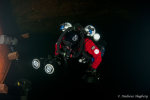
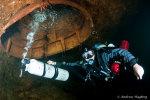
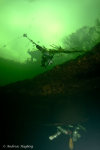


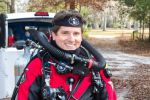
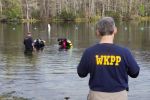
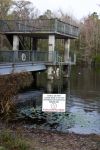
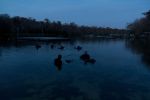
Photos by Andreas Hagberg and James Garrett.

